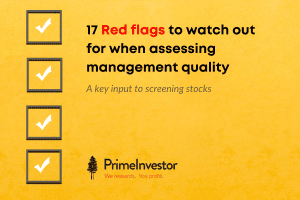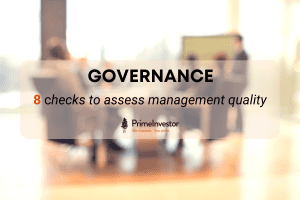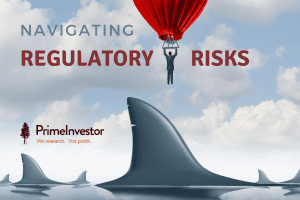
17 Red flags to watch out for when assessing management quality
Assessing management quality is a key input to screening stocks and R Balakrishnan gives us some red flags to watch out for while doing this.

Assessing management quality is a key input to screening stocks and R Balakrishnan gives us some red flags to watch out for while doing this.

What stock markets should be assessed on, where markets stand now, and other observations.

SEBI (Securities Exchange Board of India) has levelled charges of front-running against two big institutions that may Indians are invested with – LIC and Axis Mutual Fund. Front running and its close cousin – insider trading – were quite widely prevalent in the days of yore, before SEBI drafted elaborate regulations to keep such practices at bay. But what do today’s investors need to know about these malpractices? Here’s an explainer.

The recent furore surrounding the failure of Silicon Valley Bank in the US has exposed that while banking is a favourite sector with stock market investors, the fragility of the banking business is far from well-understood. Banks are held up as the engines of economic growth. Whichever sector grows, the banking sector ultimately gains. Banks are also accorded a higher valuation than most sectors during bull phases. In good times, banks made up a 40% plus weight in our leading stock market indices.

The Adani saga (still continuing, I guess) brings forth the issue of governance, management quality, and other qualitative factors that many investors consider as essential check boxes. During the time I spent in CRISIL, ‘management quality’ would set a cap on ratings. But what is ‘management quality’?

There are more theories on what works in stock investing than there are listed stocks. Each one seems to be successful at some point in time. However, there is still no single universally applicable formula. I am still in search of that magic formula. If any of you do find one, please post it in the comments section.
But if there can be said to be two warring camps on the right approach to stock investing, these are usually fundamental analysis and technical analysis. Both have loyal camps of followers who swear that their method works best.

Low interest rates and rising inflation are a dilemma for savers. There is a constant conflict between risk and return. As far as the retail investor is concerned, he looks forward to being ‘protected’ by the regulators. Financial literacy does not come easy and ninety percent of us would not know the difference between a fixed deposit and a debenture. And we would be forgiven in thinking that the term ‘secured’ debenture or bond means that every rupee we invest is safe! But where should we draw the line in the search for high interest rates?

For investors who can write a single cheque of Rs 50 lakh or more, Portfolio Management Services (PMS) have emerged a popular vehicle for investment into equities. In effect, PMS is identical to investing directly in shares, the main difference being that you have given absolute power to the PMS agency to buy/sell shares on your behalf and your portfolio choices are left to them.

Today, everyone seems to be part of Whatsapp groups, Telegram channels etc which specialize in giving stock tips. As an individual, it is an extremely demanding ask to keep searching for new stocks, new ideas etc. There is a constant bombardment of ideas and stock tips from the media- television channels, internet business websites, free data providers, charts, tipsheets and more.

Small caps are always alluring to the investor. Everyone knows that it is difficult to make quick money in large well-known and well-researched stocks. We all want to find that small gem which turns a lakh of rupees into crores. The most money is made in such cases when we can spot a company that will turn out to be a market-leading name in five to ten years. Today, the investor population has increased dramatically. Besides, information is available to everyone. This makes small cap investing both interesting and risky.

Indian investors can pay dearly if they choose to ignore regulatory risk. The risk of a regulator suddenly putting a spoke in the wheel of a sector or company that’s sailing along, cannot be quantified. It is a subjective assessment.

As per the above table, we are not yet in a bear market, though it would seem to be just round the corner. But what the data shows is that the period taken to recover from the onset of a bear market back to regaining the previous peaks can be as short as three months or as long as 74 months.
Legal Disclaimer : PrimeInvestor Financial Research Pvt Ltd (with brand name PrimeInvestor) is an independent research entity offering research services on personal finance products to customers. We are a SEBI registered Research Analyst (Registration: INH200008653). The content and reports generated by the entity does not constitute or is not intended to constitute an offer to buy or sell, or a solicitation to an offer to buy or sell financial products, units or securities. All content and information are provided on an ‘as is’ basis by PrimeInvestor Financial Research Pvt Ltd. Information herein is believed to be reliable but PrimeInvestor Financial Research Pvt Ltd does not warrant its completeness or accuracy and expressly disclaims all warranties and conditions of any kind, whether express or implied. The services rendered by PrimeInvestor Financial Research Pvt Ltd are on a best-effort basis. PrimeInvestor Financial Research Pvt Ltd does not assure or guarantee the user any minimum or fixed returns. PrimeInvestor Financial Research Pvt Ltd or any of its officers, directors, partners, employees, agents, subsidiaries, affiliates or business associates will not liable for any losses, cost of damage incurred consequent upon relying on investment information, research opinions or advice or any other material/information whatsoever on the web site, reports, mails or notifications issued by PrimeInvestor Financial Research Pvt Ltd or any other agency appointed/authorised by PrimeInvestor Financial Research Pvt Ltd. Use of the above-said information is at the user’s own risk. The user must make his own investment decisions based on his specific investment objective and financial position and using such independent advisors as he believes necessary. All intellectual property rights emerging from this website, blog, and investment solutions are and shall remain with PrimeInvestor Financial Research Pvt Ltd. All material made available is meant for the user’s personal use and such user shall not resell, copy, or redistribute the newsletter or any part of it, or use it for any commercial purpose. PrimeInvestor Financial Research Pvt Ltd, or any of its officers, directors, employees, or subsidiaries have not received any compensation/ benefits whether monetary or in kind, from the AMC, company, government, bank or any other product manufacturer or third party, whose products are the subject of its research or investment information. The performance data quoted represents past performance and does not guarantee future results. Investing in financial products involves risk. Investments are subject to market risk. Please read all related documents carefully. As a condition to accessing the content and website of PrimeInvestor Financial Research Pvt Ltd, you agree to our Terms and Conditions of Use, available here. This service is not directed for access or use by anyone in a country, especially the USA, Canada or the European Union countries, where such use or access is unlawful or which may subject PrimeInvestor Financial Research Pvt Ltd or its affiliates to any registration or licensing requirement.
Investment in securities market are subject to market risks. Read all the related documents carefully before investing.
Compliance Officer Details: Name: Srikanth Meenakshi; Email: contact@primeinvestor.
Grievance Officer Details: Name: Srikanth Meenakshi; Email: contact@primeinvestor.
Hold On
You are being redirected to another page,
Get stock & mutual fund recommendations